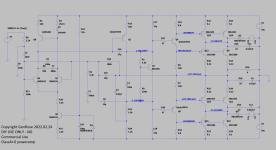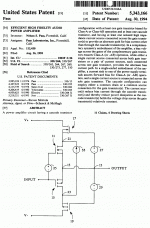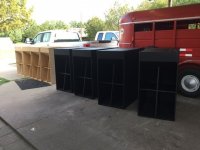Hello DIY world...
Im genrose...
i have an idea id like us to explore if we can make it work...
Diving right in.. In my opinion, class A is superior, especially for transistors.
So Class A to accommodate that dreaded cross over region and speaker control/damping but also have the prodigious output power of class AB?
This is my take... (see diagram)
Ideally as it becomes more developed one could lower that secondary voltage even more to within perhaps a volt or two above signal level..
In the very long run class A with variable proportional switching supply tracking is the ideal i think (something for another thread all together)
I welcome all with any contribution, ideas, criticism etc..
I am humbled to share my idea with such brilliant minds
Im genrose...
i have an idea id like us to explore if we can make it work...
Diving right in.. In my opinion, class A is superior, especially for transistors.
So Class A to accommodate that dreaded cross over region and speaker control/damping but also have the prodigious output power of class AB?
This is my take... (see diagram)
Ideally as it becomes more developed one could lower that secondary voltage even more to within perhaps a volt or two above signal level..
In the very long run class A with variable proportional switching supply tracking is the ideal i think (something for another thread all together)
I welcome all with any contribution, ideas, criticism etc..
I am humbled to share my idea with such brilliant minds
Attachments
key points of the design..
1. Real Class A, no "tricks"
2. Lowest heat dissipation possible. hence the secondary low voltage (12v) but at high current - i chose 12v as a good compromise between dissipation and rms output but the circut works all the way down to 6v
as is...the amp produces 20v p-pk (7v rms...6 watts @8 ohms; 12w @4ohms ) before switching to the G glass rail helpers at 70v..
3. Higher output for musical crescendos in this case i think 200w is the ideal for most speakers/locations hence the 70v rails. The output transistors draw very little current from the 70v until the aforementioned level (20v p-pk) is reached
The fft profiles is attached
1. Real Class A, no "tricks"
2. Lowest heat dissipation possible. hence the secondary low voltage (12v) but at high current - i chose 12v as a good compromise between dissipation and rms output but the circut works all the way down to 6v
as is...the amp produces 20v p-pk (7v rms...6 watts @8 ohms; 12w @4ohms ) before switching to the G glass rail helpers at 70v..
3. Higher output for musical crescendos in this case i think 200w is the ideal for most speakers/locations hence the 70v rails. The output transistors draw very little current from the 70v until the aforementioned level (20v p-pk) is reached
The fft profiles is attached
Attachments
The great Nelson Pass....🤭 im honored sir...🤩wow.. thanks for your reply..
BUT... it seems to me it was amplification in the Mh and Ghz regions... or am i missing something?
here's a link i found...
https://www.researchgate.net/scientific-contributions/Michitoshi-Hirata-65409810
In a 25+ years service field i have seen/repaired ( the class H/G...ala souncraftmen ..proton dpd...carver triac controlled...qsc common collector.. Crown Macrotech bridge..Yorkville Audio pro.. but none like a VERY LOW voltage power supply in that middle...
In your estimation would it be a worthwhile investigation regardless?😃
The closest ive ever seen is The great G Maynard's "GEM" but his operates from a single supply.😅
To be clear.. im trying to achieve full time Class A output without any "vari bias/ sliding bias system" like the Nirvana from H Dean... but with Class AB on top of all that. More towards class H (totem pole outputs) rather than class G (switched in pwr supply)
My dream is the Full Class A with some sort of tracking supply.... but we can save that as a future dream project.😁
Its Fantastic to have the opportunity to share words with such GIANTS in their field as you sir..im honored
More Anon...
BUT... it seems to me it was amplification in the Mh and Ghz regions... or am i missing something?
here's a link i found...
https://www.researchgate.net/scientific-contributions/Michitoshi-Hirata-65409810
In a 25+ years service field i have seen/repaired ( the class H/G...ala souncraftmen ..proton dpd...carver triac controlled...qsc common collector.. Crown Macrotech bridge..Yorkville Audio pro.. but none like a VERY LOW voltage power supply in that middle...
In your estimation would it be a worthwhile investigation regardless?😃
The closest ive ever seen is The great G Maynard's "GEM" but his operates from a single supply.😅
To be clear.. im trying to achieve full time Class A output without any "vari bias/ sliding bias system" like the Nirvana from H Dean... but with Class AB on top of all that. More towards class H (totem pole outputs) rather than class G (switched in pwr supply)
My dream is the Full Class A with some sort of tracking supply.... but we can save that as a future dream project.😁
Its Fantastic to have the opportunity to share words with such GIANTS in their field as you sir..im honored
More Anon...
Last edited:
Thanks again sir for your kind input...
Do you know of any commercial implementations of these said patents based on the aforementioned behavioral character i want this amp to portray?
If it is within my means I would glady pick up on one of those so as not to have to reinvent the wheel, so to speak.😀
Primarily of designs with that low voltage section? Not just divided rail voltages , but two seperate independent power supplies, and one without added complexity of switching circuitry..
Thanks again for your valued input sir..😃😎
and by the way...what do you think of the circuit in and of itself... is it warrant a time trial?😅🤔
I'll be back, ere long😁
Do you know of any commercial implementations of these said patents based on the aforementioned behavioral character i want this amp to portray?
If it is within my means I would glady pick up on one of those so as not to have to reinvent the wheel, so to speak.😀
Primarily of designs with that low voltage section? Not just divided rail voltages , but two seperate independent power supplies, and one without added complexity of switching circuitry..
Thanks again for your valued input sir..😃😎
and by the way...what do you think of the circuit in and of itself... is it warrant a time trial?😅🤔
I'll be back, ere long😁
No commercial product that I know of. The Sano patent is quite ingenious, but perhaps suffered from the complexity of multiple supplies and output stages for each channel. Same story with my patent.
Interestingly Panasonic chose instead to use a design similar to a 1973 prototype I made which today would be referred to as "non-switching".
Interestingly Panasonic chose instead to use a design similar to a 1973 prototype I made which today would be referred to as "non-switching".
Thanks again sir....
So... with all that said would you say let's go with the design and see how far we can ride this train...?😅
Btw... I'm a real novice with LtSpice...😆
More, later
So... with all that said would you say let's go with the design and see how far we can ride this train...?😅
Btw... I'm a real novice with LtSpice...😆
More, later
I think this is a lofty ambition; I've never come close.
The problem seems that commutating the outputs is possible and a few do it but the loss of heat is passed to the cascoding transistors.
Any attempt to achieve 'non-switching' seems to create extra distortions (and instabilities) which overpower the issues you try to eliminate!
Perhaps the best option is a high quiescent AB, set up so the switching occurs when the output passes 1W or so. That works well.......
Sliding bias on diamond buffers is good and quite stable. But when you look at the harmonics created by any power diamond buffer you realise there is a lot of odd order distortion artefacts.
I really can't add anything more on this topic, it's a knurly one......
HD
The problem seems that commutating the outputs is possible and a few do it but the loss of heat is passed to the cascoding transistors.
Any attempt to achieve 'non-switching' seems to create extra distortions (and instabilities) which overpower the issues you try to eliminate!
Perhaps the best option is a high quiescent AB, set up so the switching occurs when the output passes 1W or so. That works well.......
Sliding bias on diamond buffers is good and quite stable. But when you look at the harmonics created by any power diamond buffer you realise there is a lot of odd order distortion artefacts.
I really can't add anything more on this topic, it's a knurly one......
HD
Full Class A with some sort of tracking supply.... but we can save that as a future dream project.😁
oh jeez....
i think you are absolutely spot on...
i just wanted the doctor's final diagnosis...😄😅😆
and a secret wish that i was overlooking something....🤕😑
..no wonder it ain't been done before🤭..!!
well, on to the 100w Nirvana (rh) i go...
(rh)=room heater.. 😅 that's the price we pay for good sound!😁
Nevertheless, should we look at some future prospect of a full class A with a tracking supply - yes its an AMBITIOUS project, but what else do we audiophiles dream about ,right..?🤭😃🤩 "OR".. do we just abandon that sinking ship for the class D rescue boats?😆
First time to exchange words with the great man and im absolutely thrilled... You continue to lend us your mind and we are forever grateful sir...
On behalf of humanity: Live long and prosper HD
i think you are absolutely spot on...
i just wanted the doctor's final diagnosis...😄😅😆
and a secret wish that i was overlooking something....🤕😑
..no wonder it ain't been done before🤭..!!
well, on to the 100w Nirvana (rh) i go...
(rh)=room heater.. 😅 that's the price we pay for good sound!😁
Nevertheless, should we look at some future prospect of a full class A with a tracking supply - yes its an AMBITIOUS project, but what else do we audiophiles dream about ,right..?🤭😃🤩 "OR".. do we just abandon that sinking ship for the class D rescue boats?😆
First time to exchange words with the great man and im absolutely thrilled... You continue to lend us your mind and we are forever grateful sir...
On behalf of humanity: Live long and prosper HD
Possibly a Silly suggestion
BUT wouldn't a More Direct path be; Buy /Use higher efficiency Speakers?
Which don't Need high power to sound good?
BUT wouldn't a More Direct path be; Buy /Use higher efficiency Speakers?
Which don't Need high power to sound good?
Sure. Where do you want them?
Hoffman doesn't care if you’re crammed into a 400 square foot apartment. I know, nobody needs that kind of bass but it serves to illustrate the ”problem”. Everybody wants the speakers heard and not seen.
Hoffman doesn't care if you’re crammed into a 400 square foot apartment. I know, nobody needs that kind of bass but it serves to illustrate the ”problem”. Everybody wants the speakers heard and not seen.
Attachments
A few years back there was a company that released a large globe shaped speaker with the claim it produced high power with distortion free output. The amp for the bass driver was class A with the power rails derived from two tracking class D amplifiers. I can't remember the name of the company but this paper from 2004 touches on the principal. http://hdl.handle.net/1721.1/28384
One idea could be to vary the rail voltages, a la buck converters with a duty cycle that increases when a certain threshold is exceeded.
Ideally, the PSU would be smoothly ramped up in anticipation of an upcoming peak in the analogue signal path. A nice idea for digital audio. Although I guess a "true analogue" amplifier could be also based on modulating and filtering a voltage source to produce an audio signal. It doesn't always have to be either switching XOR linear.
Ideally, the PSU would be smoothly ramped up in anticipation of an upcoming peak in the analogue signal path. A nice idea for digital audio. Although I guess a "true analogue" amplifier could be also based on modulating and filtering a voltage source to produce an audio signal. It doesn't always have to be either switching XOR linear.
That would be a class TD amplifier - already been done, at least for normal AB type operation. There isn’t any reason the amp couldn’t be biased into class A, other than the dissipation issues. The down converters on the power supplies do create digital noise which is impossible to completely eliminate, and do have a finite response time. The finite response time when running in class A would still necessitate a high SOA in the output stage to deal with the occasional high peak dissipation, but at least the average thermal load heating up the house would be less.
Some of the cheap clones of the well respected brands like Labgruppen are pretty rough - full of easily audible digital hash and stair step looking waveforms. Only really suitable for subwoofers. But that’s not an intrinsic limitation - just what happens when someone clones a circuit they don‘t understand.
Some of the cheap clones of the well respected brands like Labgruppen are pretty rough - full of easily audible digital hash and stair step looking waveforms. Only really suitable for subwoofers. But that’s not an intrinsic limitation - just what happens when someone clones a circuit they don‘t understand.
oh jeez....
i think you are absolutely spot on...
i just wanted the doctor's final diagnosis...😄😅😆
and a secret wish that i was overlooking something....🤕😑
..no wonder it ain't been done before🤭..!!
well, on to the 100w Nirvana (rh) i go...
(rh)=room heater.. 😅 that's the price we pay for good sound!😁
Nevertheless, should we look at some future prospect of a full class A with a tracking supply - yes its an AMBITIOUS project, but what else do we audiophiles dream about ,right..?🤭😃🤩 "OR".. do we just abandon that sinking ship for the class D rescue boats?😆
First time to exchange words with the great man and im absolutely thrilled... You continue to lend us your mind and we are forever grateful sir...
On behalf of humanity: Live long and prosper HD
I have not read this post, but it should be awarded golden emoji award for most useless emojis used
Not to be rude, but where is Halcro now?

- Home
- Amplifiers
- Solid State
- Class A amp with dual Linear supply



